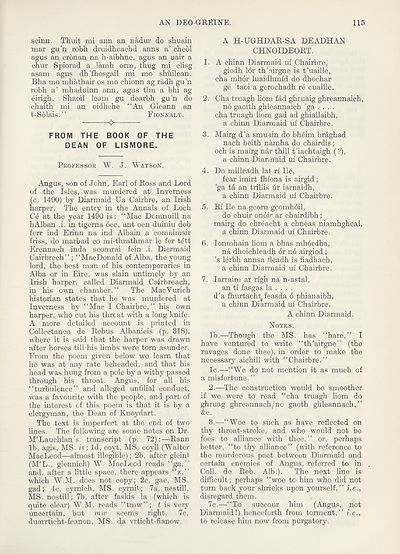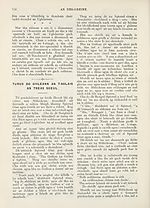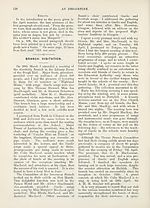An Comunn Gàidhealach Publications > Deo-gréine > Volume 17, October 1921 to September 1922
(123) Page 115
Download files
Complete book:
Individual page:
Thumbnail gallery: Grid view | List view

AN DEO-GREINE.
115
seinn. Thuit mi arm an nadur do shuain
mar gu’n robh druidheachd arms a’ cheol
agus an cronan na h-aibhne, agus an uair a
chur Spiorad a lamb orm, thug mi clisg
asam agus dh’fhosgail mi mo shiiilean.
Bha mo mhathair os mo chionn ag radh gu ’n
robh a’ mhaduinn ann, agus tim a bhi ag
eirigh. Shaoil learn gu dearbh gu’n do
chaith mi an oidhche “An Gleann an
t-S61ais. ’ ’ Fionnalt.
FROM THE BOOK OF THE
DEAN OF LISMORE.
Professor W. J. Watson.
Angus, son of John, Earl of Ross and Lord
of the Isles, was murdered at Inverness
(c. 1490) by Diarmaid Ua Cairbre, an Irish
harper. The entry in the Annals of Loch
Ce at the year 1490 is: “Mac Domnuill na
hAlban .i. in tigema 6cc, ant oen duiniu dob
ferr ind Erinn na ind Albain a comaimsir
friss, do marbad co mi-thrathmar le fer t^tt
Erennach inda seomrai fein .i. Diermaid
Cairbrech” ; “MacDonald of Alba, the young
lord, the best man of his contemporaries in
Alba or in Eire, was slain untimely by an
Irish harper, called Diarmaid Cairbreach,
in his own chamber.’’ The MacVurich
historian states that he was murdered at
Inverness by “Mac I Chairbre, ” his own
harper, who cut his threat with a long knife.
A more detailed account is printed in
Collectanea de Rebus Albanicis (p. 318),
where it is said that the harper was drawn
after horses till his limbs were torn asunder.
From the poem given below we learn that
he was at any rate beheaded, and that his
head was hung from a pole by a withy passed
through his throat. Angus, for all his
“turbulence” and alleged unfilial conduct,
was a favourite with the people, and part of
the interest of this poem is that it is by a
clergyman, the Dean of Knoydart.
The text is imperfect at the end of two
lines. The following are some notes on Dr.
M’Lauchlan's transcript (p. 72):—Rann
lb, agis, MS. is; Id, coyt, MS. coyll (Walter
MacLeod—almost illegible); 2b, after gleint
(M‘L., glennich) W. MacLeod reads “ga,”
and, after a little space, there appears “z,”
which W.M. does not copy; 2c, gae, MS.
gad; 4c, eyrnich, MS. eyrnit; 7a, nestill,
MS. nostill; 7b, after faskis la (which is
quite clear) W.M. reads “tmw”; t is very
uncertain, but rmv seems right. 7c,
duarrticht-feanon, MS. da vrticht-fianow.
A H-UGHDAR-SA DEADHAN
CHNOIDEORT.
1. A chinn Diarmaid ui Chairbre,
giodh lor th’nirgne is t’uaille,
cha mhor luaidhmid do dhochar
ge ’taoi a gcrochadh r£ cuaille.
2. Cha truagh Horn fad ghruaig ghreannaich,
no gaoith ghleannaich ’ga . . . .
cha truagh liom gad ad ghiallaibh,
a chinn Diarmaid ul Chairbre.
3. Mairg d’a smuain do bh&m br&ghad
nach beith namha do chairdis;
och is mairg n&r thill t’iachtaigh (?),
a chinn Diarmaid ui Chairbre.
4. Do milleadh lat ri He,
fear imirt fhiona is airgid;
’ga t& an trillis ur iarnaidh,
a chinn Diarmaid ui Chairbre.
5. Ri He na gcom gcomhdil,
do chuir onoir ar chairdibh;
mairg do chreacht a chneas niamhgheal,
a chinn Diarmaid ui Chairbre.
6. lonmhain liom a bhas mhordha,
na dhoichleadh or n6 airgiod;
’s lerbh annsa fleadh is fiadhach,
a chinn Diarmaid ui Chairbre.
7. larraim ar righ na n-astal,
an ti fasgas la ... .
d’a fhurtacht#feasda 6 phianaibh,
a chinn Diarmaid ui Chairbre.
A chinn Diarmaid.
Notes.
lb. —Though the MS. has “hare,” I
have ventured to write “th’airgne” (the
ravages done thee), in order to make the
necessary aichill with “Chairbre.”
lc. —“We do not mention it as much of
a misfortune.”
2. —The construction would be smoother
if we were to read “cha truagh Horn do
ghruag ghreannach/no gaoth ghleannach,”
&c.
3. —“Woe to such as have reflected on
thy throat-stroke, and who would not be
foes to alliance with thee,” or, perhaps
better, “to thy alliance” (with reference to
the murderous pact between Diarmaid and
certain enemies of Angus, referred to in
Coll, de Reb. Alb.). The next line is
difficult; perhaps “woe to him who did not
turn back your shrieks upon yourself,” i.e.,
disregard them.
7c.—“To succour him (Angus, not
Diarmaid!) henceforth from torment,” i.e.,
to release him now from purgatory.
115
seinn. Thuit mi arm an nadur do shuain
mar gu’n robh druidheachd arms a’ cheol
agus an cronan na h-aibhne, agus an uair a
chur Spiorad a lamb orm, thug mi clisg
asam agus dh’fhosgail mi mo shiiilean.
Bha mo mhathair os mo chionn ag radh gu ’n
robh a’ mhaduinn ann, agus tim a bhi ag
eirigh. Shaoil learn gu dearbh gu’n do
chaith mi an oidhche “An Gleann an
t-S61ais. ’ ’ Fionnalt.
FROM THE BOOK OF THE
DEAN OF LISMORE.
Professor W. J. Watson.
Angus, son of John, Earl of Ross and Lord
of the Isles, was murdered at Inverness
(c. 1490) by Diarmaid Ua Cairbre, an Irish
harper. The entry in the Annals of Loch
Ce at the year 1490 is: “Mac Domnuill na
hAlban .i. in tigema 6cc, ant oen duiniu dob
ferr ind Erinn na ind Albain a comaimsir
friss, do marbad co mi-thrathmar le fer t^tt
Erennach inda seomrai fein .i. Diermaid
Cairbrech” ; “MacDonald of Alba, the young
lord, the best man of his contemporaries in
Alba or in Eire, was slain untimely by an
Irish harper, called Diarmaid Cairbreach,
in his own chamber.’’ The MacVurich
historian states that he was murdered at
Inverness by “Mac I Chairbre, ” his own
harper, who cut his threat with a long knife.
A more detailed account is printed in
Collectanea de Rebus Albanicis (p. 318),
where it is said that the harper was drawn
after horses till his limbs were torn asunder.
From the poem given below we learn that
he was at any rate beheaded, and that his
head was hung from a pole by a withy passed
through his throat. Angus, for all his
“turbulence” and alleged unfilial conduct,
was a favourite with the people, and part of
the interest of this poem is that it is by a
clergyman, the Dean of Knoydart.
The text is imperfect at the end of two
lines. The following are some notes on Dr.
M’Lauchlan's transcript (p. 72):—Rann
lb, agis, MS. is; Id, coyt, MS. coyll (Walter
MacLeod—almost illegible); 2b, after gleint
(M‘L., glennich) W. MacLeod reads “ga,”
and, after a little space, there appears “z,”
which W.M. does not copy; 2c, gae, MS.
gad; 4c, eyrnich, MS. eyrnit; 7a, nestill,
MS. nostill; 7b, after faskis la (which is
quite clear) W.M. reads “tmw”; t is very
uncertain, but rmv seems right. 7c,
duarrticht-feanon, MS. da vrticht-fianow.
A H-UGHDAR-SA DEADHAN
CHNOIDEORT.
1. A chinn Diarmaid ui Chairbre,
giodh lor th’nirgne is t’uaille,
cha mhor luaidhmid do dhochar
ge ’taoi a gcrochadh r£ cuaille.
2. Cha truagh Horn fad ghruaig ghreannaich,
no gaoith ghleannaich ’ga . . . .
cha truagh liom gad ad ghiallaibh,
a chinn Diarmaid ul Chairbre.
3. Mairg d’a smuain do bh&m br&ghad
nach beith namha do chairdis;
och is mairg n&r thill t’iachtaigh (?),
a chinn Diarmaid ui Chairbre.
4. Do milleadh lat ri He,
fear imirt fhiona is airgid;
’ga t& an trillis ur iarnaidh,
a chinn Diarmaid ui Chairbre.
5. Ri He na gcom gcomhdil,
do chuir onoir ar chairdibh;
mairg do chreacht a chneas niamhgheal,
a chinn Diarmaid ui Chairbre.
6. lonmhain liom a bhas mhordha,
na dhoichleadh or n6 airgiod;
’s lerbh annsa fleadh is fiadhach,
a chinn Diarmaid ui Chairbre.
7. larraim ar righ na n-astal,
an ti fasgas la ... .
d’a fhurtacht#feasda 6 phianaibh,
a chinn Diarmaid ui Chairbre.
A chinn Diarmaid.
Notes.
lb. —Though the MS. has “hare,” I
have ventured to write “th’airgne” (the
ravages done thee), in order to make the
necessary aichill with “Chairbre.”
lc. —“We do not mention it as much of
a misfortune.”
2. —The construction would be smoother
if we were to read “cha truagh Horn do
ghruag ghreannach/no gaoth ghleannach,”
&c.
3. —“Woe to such as have reflected on
thy throat-stroke, and who would not be
foes to alliance with thee,” or, perhaps
better, “to thy alliance” (with reference to
the murderous pact between Diarmaid and
certain enemies of Angus, referred to in
Coll, de Reb. Alb.). The next line is
difficult; perhaps “woe to him who did not
turn back your shrieks upon yourself,” i.e.,
disregard them.
7c.—“To succour him (Angus, not
Diarmaid!) henceforth from torment,” i.e.,
to release him now from purgatory.
Set display mode to:
![]() Universal Viewer |
Universal Viewer | ![]() Mirador |
Large image | Transcription
Mirador |
Large image | Transcription
| An Comunn Gàidhealach > An Comunn Gàidhealach Publications > Deo-gréine > Volume 17, October 1921 to September 1922 > (123) Page 115 |
|---|
| Permanent URL | https://digital.nls.uk/127171449 |
|---|
| Description | Leabhar 17, Treasamh Mios an Fhoghair 1921 gu Dara Mìos an Fhoghair 1922 |
|---|---|
| Attribution and copyright: |
|
| Description | This contains items published by An Comunn, which are not specifically Mòd-related. It includes journals, annual reports and corporate documents, policy statements, educational resources and published plays and literature. It is arranged alphabetically by title. |
|---|
| Description | A collection of over 400 items published by An Comunn Gàidhealach, the organisation which promotes Gaelic language and culture and organises the Royal National Mòd. Dating from 1891 up to the present day, the collection includes journals and newspapers, annual reports, educational materials, national Mòd programmes, published Mòd literature and music. |
|---|---|
| Additional NLS resources: |
|

